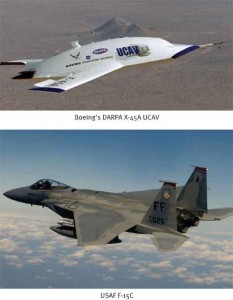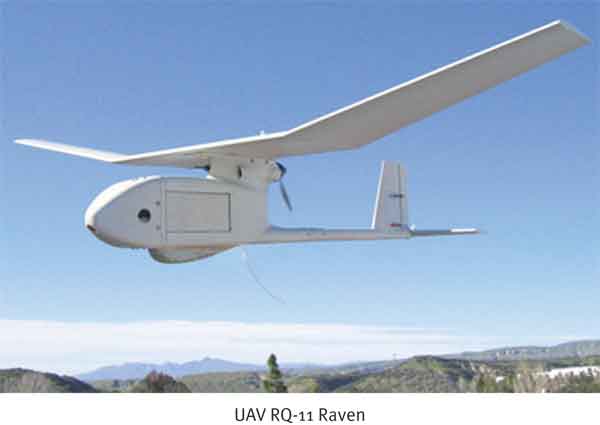Armed Reconnaissance and SEAD
US military strategy focused on targeting Osama bin Laden and his training camps with Tomahawk Land Attack Missiles (TLAM). This however created a large gap between detection and destruction. The answer was an “armed reconnaissance” platform to locate and strike targets in real-time sequence. Technological innovation led the US Air Force to fit two 45-kg laser-guided Hellfire-C missiles to a Predator UAV. The same Predator has been credited with two successful attacks on Al-Qaeda operatives in 2001 and 2002.
By performing these ‘strike’ missions, these incidents demonstrated the efficacy of armed UAVs in the global war against terrorism. The Predator UAV was credited with two strikes in Operation Iraqi Freedom in March 2003 – one against an anti-aircraft vehicle while the other was against a television satellite dish in Baghdad. The US is currently developing a new version of the armed Predator UAV called Predator B which is slated to have the capability to carry eight Hellfire missiles instead of two. The US is also developing newer UCAV platforms capable of primary offensive mission of strike and SEAD.
For the SEAD mission, one way would be to use the UAV to locate, designate and even jam the target transmitter and then attack it with UCAVs/manned fighters. UCAVs integrated with manned and unmanned assets such as AWACS, F-16, F-117, Global Hawk, and communications satellites will play a vital role in future SEAD missions reducing risk to manned assets in this high threat environment.
The common threat to UAVs/UCAVs and manned fighters is from modern SAMs with ranges estimated to be between 50 and 250 miles, which will force a nation to develop strategies and systems to reduce the risk to its pilots. Missiles launched from a distance from mobile SAM sites are difficult to detect implying that the friendly aircraft/UAVs will have a very narrow zone to avoid the SAMs.
Counter Air Operations
During Operation Desert Storm, the coalition forces flew over 13,000 Counter Air missions, ensuring air superiority of the skies over Iraq with the USAF F-15C, USN F-14A/D, and USN and USMC F/A-18 aircraft. The same air assets were available during Operation Allied Force for the Counter Air Operations. Lockheed Martin’s F-22 Raptor is likely to play a key role in America’s air superiority efforts in the years ahead. Stealth, manoeuvrability and cost will be the most important pre-requisites for air superiority fighters of the future. The UCAVs presently under development are slated to be equally stealthy, more manoeuvrable and available at competitive costs.
Aerial combat is the most challenging mission for manned aircraft and it is believed that missiles may not always destroy the adversary especially one equipped with significant weapons and capabilities like the MiG-29 Fulcrum and the Su-27 Flanker. Close engagement would therefore continue to be necessary. The degree of Situational Awareness required for a UCAV operator to perform as well as the fighter pilot will determine the success of the engagement and this is where the communications bandwidth will play a critical role. Autonomous systems will reduce bandwidth requirements. However, it is unlikely that the UCAV will replace the manned aircraft in all Counter Air Operations as some politically sensitive targets will still need a human operator to make the “kill decision”.
Cost Effectiveness
The cost of manned combat aircraft ranges from $65 million for the Joint Strike Fighter to $1.2 billion for the B-2 Spirit bomber. UAV costs on the other hand, range from the Marine Corp’s developmental Dragon Eye at $30,000 per unit to Global Hawk at $57 million. The total system cost of the Predator UAV which is about $28.3 million, is about the same as a single seat F-16A.
 Although the unmanned platform might be cheaper than its manned counterpart, the UAV system on the whole is not always less expensive. Besides, the DARPA/Boeing X-45 UCAV is estimated to cost about $25 million per unit.
Although the unmanned platform might be cheaper than its manned counterpart, the UAV system on the whole is not always less expensive. Besides, the DARPA/Boeing X-45 UCAV is estimated to cost about $25 million per unit.
Technology
Up to 40 per cent of the weight and volume of a manned fighter is made up of the human interface and life-support systems. By removing these, as well as the redundancy and fault tolerance demanded of manned systems, the designer expects to cut the weight by around 10,000lbs, incorporate stealth technology and also make it more manoeuvrable. There is still no UCAV capable of aerial combat operational with the US forces.
Performance
The manoeuvrability of UCAVs could vastly exceed that of manned aircraft. Even with G-suits to keep blood from pooling in the lower extremities of the body, seated human beings lose consciousness when subjected to manoeuvres involving higher than –3G or +10G. Humans are quickly exhausted by continuous heavy manoeuvring. With the pilot dispensed with, the next constraint appears to be the engine. High centrifugal forces would cause engines to fail above 20G.The range and speed of UCAVs is also increased by their improved aerodynamics and reduced weight. Though un-refuelled loiter time may be reduced, in-flight refuelling will enhance the utilisation of the UCAV as they will be able to fly longer unrestricted by the fatigue factor!
Payload
As far as the payload is considered, UCAVs perhaps are not likely to have the same capability as manned fighters in the foreseeable future. The US is reported to be designing a UCAV with 2x1000lbs payload. However, another US initiative, the Miniaturised Munitions Technology Demonstration aims to develop advanced explosives and penetrators that produce the same effect against hardened targets with a 250lb-munitions as a conventional 2000lb-class bomb thereby reducing the difference in payload capacity between the UCAV and the manned fighter.
Communications
One of the brightest prospects for UCAV operations is the ability to form a distributed network in the sky that coordinates diverse sensors and weapons in real-time. Although they could function autonomously, there will be a significant amount of operator input and supervision. At a minimum, UCAVs will have to receive data on flight path, waypoints, threats as also on location and type of targets. Weapons release will require confirmation by a human operator and UCAVs will have to carry a reliable self-destruct mechanism not only to prevent collateral damage should they go out of control but also to safeguard sensitive technology and the data they carry onboard. They will also have to receive and respond to queries for location and status.
UCAVs might also broadcast intelligence on targets as they are encountered. This is best illustrated by the demands for bandwidth in the Gulf War. The Global Hawk alone consumed five times the total bandwidth used by the entire US military. It is reported that the US bandwidth requirement has increased eightfold due to the conflict in Afghanistan. Thus the demands on bandwidth for UAV/UCAV operations may be critical to their optimum utilisation.
Survivability and Reliability
The most significant factor in determining the cost-effectiveness of a UCAV is its survivability. Due to their stealth and manoeuvrability, UCAVs are considered more survivable than manned fighters although they are vulnerable to small arms fire while operating at low altitudes and close to the target systems. Interestingly, the current UAV accident rate is an order of magnitude over that of manned aircraft. This rate will not be acceptable for a multi-million dollar UCAV that costs as much as a manned fighter. According to a US Congress study, in 2003, the life of a UAV is 200 hours, which does not compare favourably with the 40,000 hours for a manned aircraft. Nevertheless, it is important to remember that these systems are still under development and would need to undergo extensive testing to prove their technological capability. Unless they are tried and tested in actual operations, these systems are unlikely to challenge the manned platform in any significant way.
Conclusion
UAVs enhance the ability of a nation to intervene militarily whenever and wherever its interests are threatened whether through ISR missions or in a combat capacity through surgical strikes, pre-emptive SEAD missions without the intervention of manned aircraft. The UAV is an innovative weapon system but it is not yet one with the capability to replace manned aircraft. Likewise, the unmanned platform has lower level of flexibility and greater vulnerability. Besides their lack of ability to analyse its operational environment, many advanced unmanned platforms are as expensive as manned aircraft; their high costs making their loss unacceptable. Their software complexity, automation and communications architecture make them operationally unreliable for many missions. Thus far, communications technology has limited the effectiveness of the unmanned platform, especially its armed version.
UAVs are going to perform the critical ISR mission in future military operations where they are likely to fly tactical missions together with their manned counterparts upon obtaining cues from satellites. MAVs with their potential to substantially transform urban operations and special operations missions will see their role enhanced in future conflicts. In the future, UCAVs and armed UAVs can also perform strike and limited SEAD missions and are likely to play an important role in electronic attack missions. The present communications and automation technology shortfall needs to be surmounted before the UAVs/UCAVs are suitable for combat missions. The future combat arena may well see both the fighter pilot and the UAV/UCAV in complementary roles.





